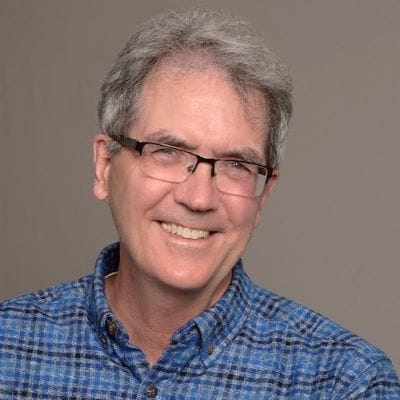North Kansas City Streetcar Plan Hits $222M Roadblock

Published January 6th, 2023 at 12:30 PM
By Kevin Collison
A proposal to extend the streetcar to North Kansas City has hit a hard fiscal reality; it’s far too expensive to build utilizing the local funding method that has developed the system so far on Main Street and to the riverfront.
It would cost up to $222 million to extend the streetcar from the River Market to downtown North KC, a figure larger than the community could raise on its own if it were to seek a 50 percent federal match, according to a study’s preliminary findings.
That estimate, which was presented to city officials last August, doesn’t include the $4.7- $7.9 million annual operation and maintenance costs for an extension, according to a study that’s been paused as streetcar advocates ponder next moves.
“We don’t have a path sufficient to match federal funding and to operate the system,” said Tom Gerend, executive director of the Kansas City Streetcar Authority. “We have to find an alternative to how we’re going to pay for it.”
The results are further evidence that any new streetcar routes beyond those currently underway to UMKC and Berkley Riverfront Park, including a potential east-west route, will require a broader local funding method than the current transportation development district (TDD).
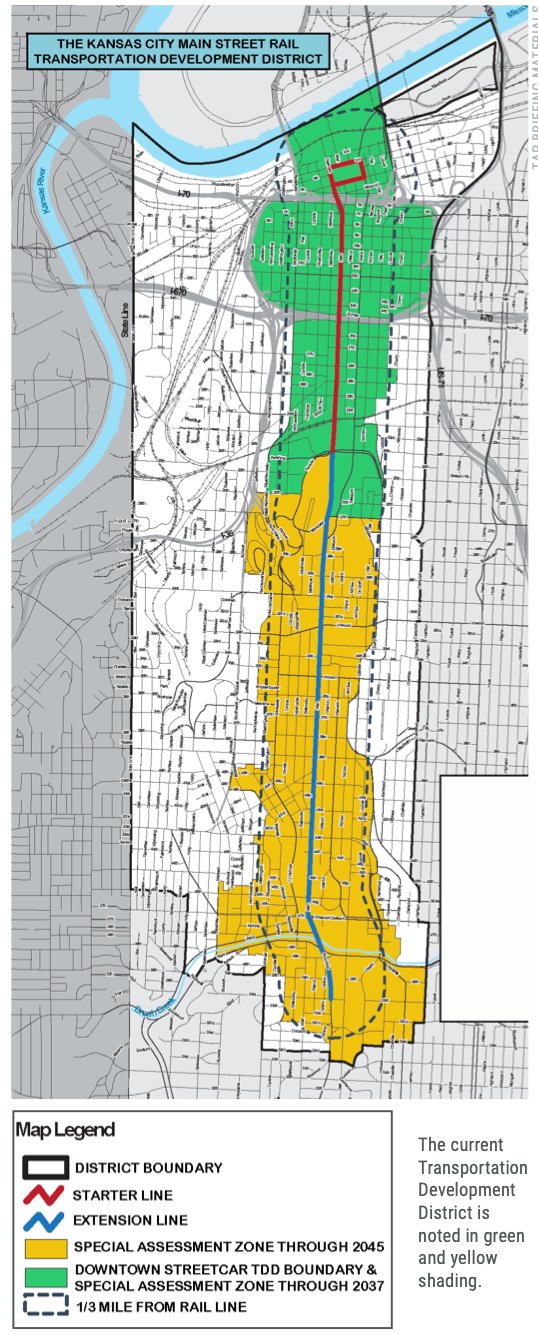
The Main Street streetcar route gets its local funding from a property tax surcharge and additional sales tax imposed on businesses and properties within what’s called a Transportation Development District.
A TDD, which is approved voters living in the district, relies on sales and property tax surcharges imposed on businesses and property owners within the streetcar corridor.
“The TDD we’ve applied south of the river is not sufficient north of the river,” Gerend said. “We need to find creative alternatives to see if there is a path forward and we’re not ready yet.”
The presentation to the North KC City Council last summer was based on the results of a study begun more than a year ago by the Kansas City Streetcar Authority, the KC Area Transportation Authority and City of North Kansas City.
The study, which is looking at the design and funding of the extension, had been expected to be completed by mid-2022, but its now been delayed temporarily by the Streetcar Authority pending additional financial analysis. It was done by Kimley-Horn, a transportation consultant.
In a presentation to North KC officials, Jeff McKerrow of Kimley-Horn said even with a TDD imposing a sales tax on the entire city and a property tax surcharge within one-third mile of the route, it would raise about $74.6 million, far short of the 50 percent match usually expected to obtain federal funding.
In addition, only about 40 percent of the capital costs for a potential NKC extension, not including buying streetcars and building a maintenance facility, would be for actual streetcar construction work in North Kansas City.
The remaining capital costs would be incurred on the state-owned Heart of America Bridge and on the Kansas City side of the river, according to McKerrow.
McKerrow told the Council other potential local funding sources outside North KC included state money for the bridge work; a larger multi-project TDD that could include a potential new east-west route in Kansas City, and new transit taxes implemented on a county or regional basis.
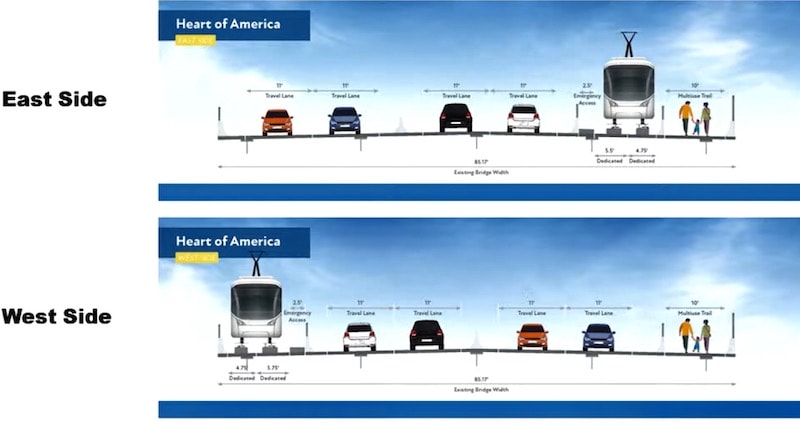
A schematic showing how a streetcar would utilize the Heart of America bridge, the preferred route would be on the east side. (Rendering from Kimley-Horn presentation)
Gerend also told the Council there may be new sources of federal funding.
“Not just the climate bill but the infrastructure bill,” he said.
“We’ve seen an influx of an expansion of the existing programs with the same number of projects in the queue when those programs are much larger.
“There’s more opportunity than ever, getting in line and doing the due diligence is important.”
But Gerend said it will take substantial work on the local front to prepare not only the North Kansas City plan to apply for potential federal matching grants, but other rail projects as well.
“There’s momentum and interest and energy, but we need a viable path to build and operate new lines,” Gerend said.
“It takes a village and this doesn’t happen if there isn’t an agreed upon process. We’ll be looking at options and talking to MoDOT to see if there are resources to bring down the local costs.”
The latest North Kansas City streetcar report was commissioned to update the findings of a NorthRail Streetcar Study done in 2014.
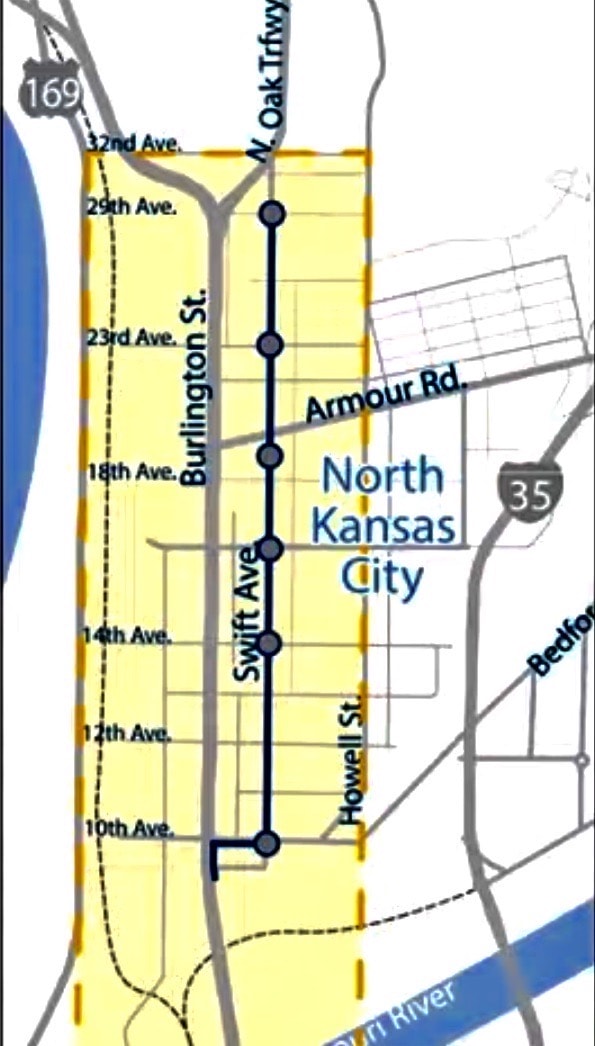
The recommended North Kansas City route would run down Swift Street and require a jog on Tenth Avenue from the Heart of America Bridge. (Map from Kimley-Horn presentation)
The NorthRail study recommended a route that would cross the Heart of America (Highway 9) Bridge and extend down Burlington Avenue to Armour Road. At the time, it estimated the cost of the project at $134 million.
The preliminary results of the new study however, not only raised the estimated capital costs of the potential extension to $222 million, but also recommended the route be on Swift Street instead of Burlington.
McKerrow told Council members a Burlington route, while it cost about $13 million less than the Swift alternative, would require the artery to be narrowed from three lanes of vehicle traffic each way to two.
That could be a challenge to the Missouri Department of Transportation, which operates the road as Highway 9.
“The more changes you took along those routes, the less it looks like a MoDOT facility and more like a city street,” McKerrow said. “Which begins the question of if you make those changes would that still be a MoDOT route or not.”
The study also indicates a 1.9-mile streetcar route along Swift would serve significantly more residents and employees than a 1.6-mile route on Burlington, and provide more opportunities for redevelopment.
An opinion survey done for the study found overwhelming support for the Swift alternative. It suggested a North KC streetcar route would be a popular option for riders going to entertainment and restaurant destinations, less so for commuting.
The new study also recommended the streetcar extension go on the east side of the Heart of America Bridge at an estimate cost of $32.9 million. Running the line on the west side would cost $22 million.
If the Swift route were chosen, it would require a one-block jog of the line east on Tenth Avenue from the bridge. A Burlington route would roll straight ahead from the bridge.
There also were two recommendations for how the NKC streetcar would enter and leave the River Market to connect with the existing line.
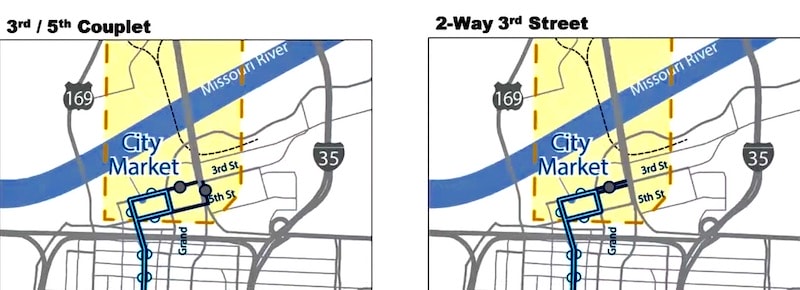
Two methods were studied to connect the River Market streetcar route to the Heart of America Bridge. The preferred option was a ‘couplet” using Third and Fifth streets. (Map from Kimley-Horn presentation)
One calls for a “couplet” that would use Third and Fifth streets at a cost of $28.6 million. The other alternative calls for a two-way streetcar route on Third Street that would cost $25.7 million.
Survey respondents preferred the one-way couplet approach using Third and Fifth streets.
The consensus response from North Kansas City Council members appeared to agree with the survey preferences, using the east side of the Heart of America Bridge and running the line along Swift to Armour Road.
Councilman Wes Graves originally had supported the Burlington route until the presentation.
“That’s a huge buzz kill when you mention the lanes of traffic would be reduced from three lanes to two,” he said. “That was like dumping a cold bucket of water, we already have traffic difficulties here.”
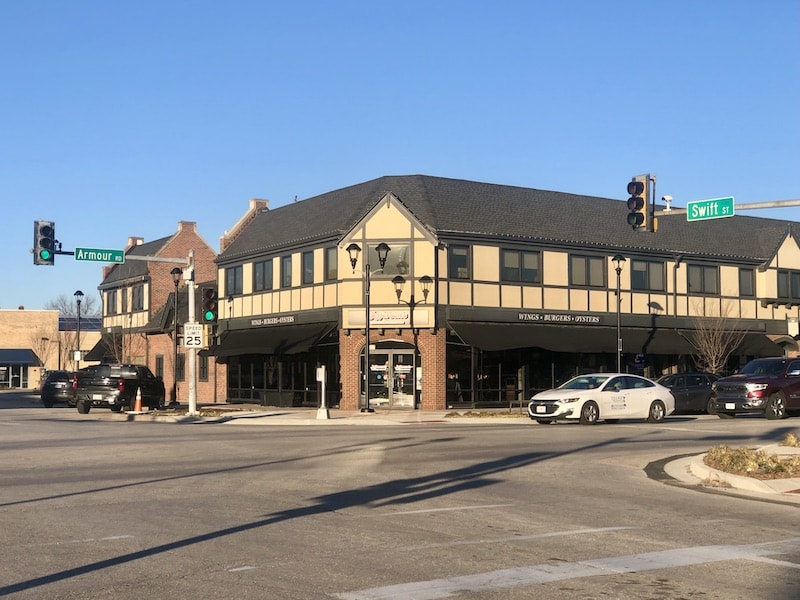
The recommended extension would reach from the River Market to the intersection of Swift and Armour Road in downtown North Kansas City.
Graves also was concerned about the potential of North Kansas City becoming a “parking lot” for other Northland communities if the route goes no farther than Armour Road.
“They’re going to drive down here, park their car and get on the streetcar to go to River Market or Union Station,” he said. “We’re going to end up being a parking lot essentially if this is the most northern point of the streetcar.”
McKerrow said the Swift alternative would be better than the Burlington route if rail transit is someday extended farther north, but cautioned it would likely not be a streetcar.
“On extending to airport, it’s a long ways to go,” he said.
“It would probably be a different technology than the streetcar to get you to the airport. It doesn’t quite have the speeds you’d normally see.”


